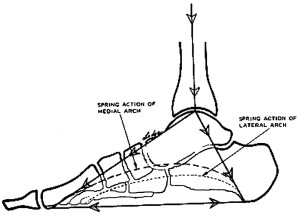The bosu ball gets a rap. People do all sorts of weird things in the gyms with them, but having said that, this post isn’t about complaining about those people. Instead I want to discuss the importance of utilizing the bosu ball for leg and hip development, as well as improving your training relative to sport. The above video demonstrates two exercises (the 8-point drill and the lateral jump-off) that will help you create elasticity and strength in your ankles, knees, and hips. The drills are intended to teach you how to absorb the weight of your body onto your foot.
It goes like this- the foot is a tetrahedron. You’ve got three arches, a lateral, medial, and transverse arch, all of which contribute to creating the ‘spring’ effect when you walk, run, jump, throw, etc. Beyond this, we all stand in ways that make our gravity weight land in a particular way on our foot. Your weight might land all on the ball of your foot, others rock out to the sides, and some people live in their heels. The point is- finding centre aint easy, and if you’re trying to build healthy ankles, knees, and hips, you better have a strategy for integrating vector training into your workouts.(What is vector training? Think of it as directional movement, doing something that requires you to change direction, change plane of motion, change muscular recruitment to create desired response.)
This lets your arches be maintained and developed in a way that make you better at any activity, and improves the functionality of your foot (and ankle, knee, hip, etc). The bosu drills train the motor-receptors in the foot to recognize how to respond and adapt to different surfaces at different angles. And with your weight load constantly landing differently (your foot rarely lands evenly), the bosu challenges the pyramid under your foot to stabilize and balance you. Just from this simple- yet highly effective drill- you get more ligaments, tendons, and muscles in the lower body to come into the equation to create the movement. So now your quads, hams, calves, foot muscles, hips, glutes, everything is working that much more than just some boring routine warmup you’ve done a thousand times.
The reason I love these two drills is that they teach you motor mechanics of your legs, but more importantly they teach your foot how to take the load of your body weight in a way that produces an elastic effect (explosion) on the ‘push off’ of the foot. For the more advanced athlete, the lateral jump-off is a terrific way to strengthen the functionality of your glutes during a dynamic explosive action. Prop the bosu against the wall and see if you can focus on pressing out from the heel of the planted foot, to then laterally explode on to the bosu, and see how consistent you can be with landing on your foot after the jump each time. When done correctly this will get fatiguing, in which case you change sides. 10-20 reps per side is plenty, but again repetition has nothing to do with it. Make the goal precise, deliberate, intentional movement. Doing these regularly will teach you how to move faster, be more agile, and ultimately have more gluteal and lower body strength so that you can withstand longer, more difficult challenges that lie ahead of your training regimen.
So you’ve got the 8-point drill and the more advanced lateral jump-off, both highly effective movements for building strength in the feet and legs. If you’re an aspring runner, I encourage you to teach yourself how to move on the bosu before you aimlessly go out running to lose weight. Do the 8-point drill for 5, 10, 15 minutes, switching feet every 5-10x through. Feel yourself improving in lateral speed and add the arms. Integrating this into your training will start to build your joints and intrinsic foot muscles in a way that teaches them how to absorb your body weight without the negative side effects of joint inflammation that you would get going for a run. If you are a runner, I would still utilize this as a learning tool to fine tune your foot mechanics and strengthen your glutes through the sagittal frontal plane. To make it more challenging go at different speeds. Example; do 10 rounds at speed 1 (5 cycles per side, marching), 8 at speed 2 (slightly faster, 4 cycles per side), and then 6 at a top speed (sprinting, 3 per side), then dial it back down. Do this for 2-5 rounds and you’ll start to feel cooked!
Walking, marching, and therefor running are some of the most complicated movements there are, and although they seem easy and rudimentary, they constantly need to be tweaked if you plan on wanting to do them successfully throughout your lifetime, without regressing, or even worse, getting injured. Intrinsic foot muscles hardly ever get worked, and we sometimes forget the importance of training balance, stability, and leg functionality, so I want you to start incorporating this into your warmup, workout, and training. These exercises can always be made harder, but stick to the simple 8-pointer for a few months before looking to advance it. And If you are serious about getting better at running, consult a running coach like myself to learn about your gait, breath, and figure out where your gaps are. Runner, not a runner, aspiring to be a runner, it doesn’t matter who you are anybody will benefit from adding this aerobic work to their gym time.
Let me know how it goes! Training is a practice, not a competition.

